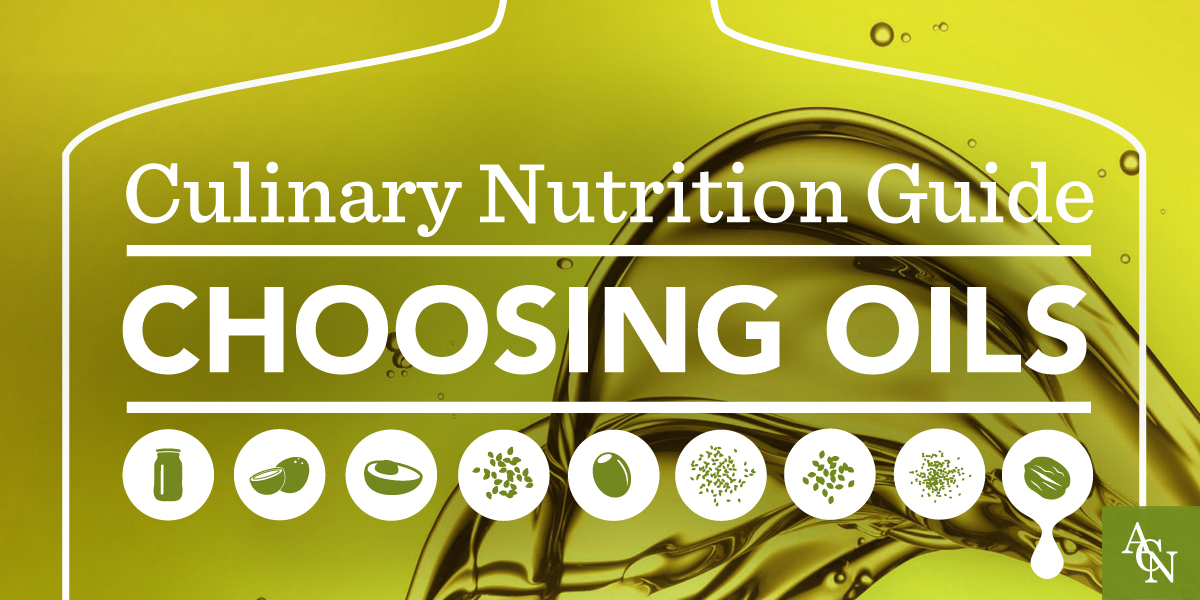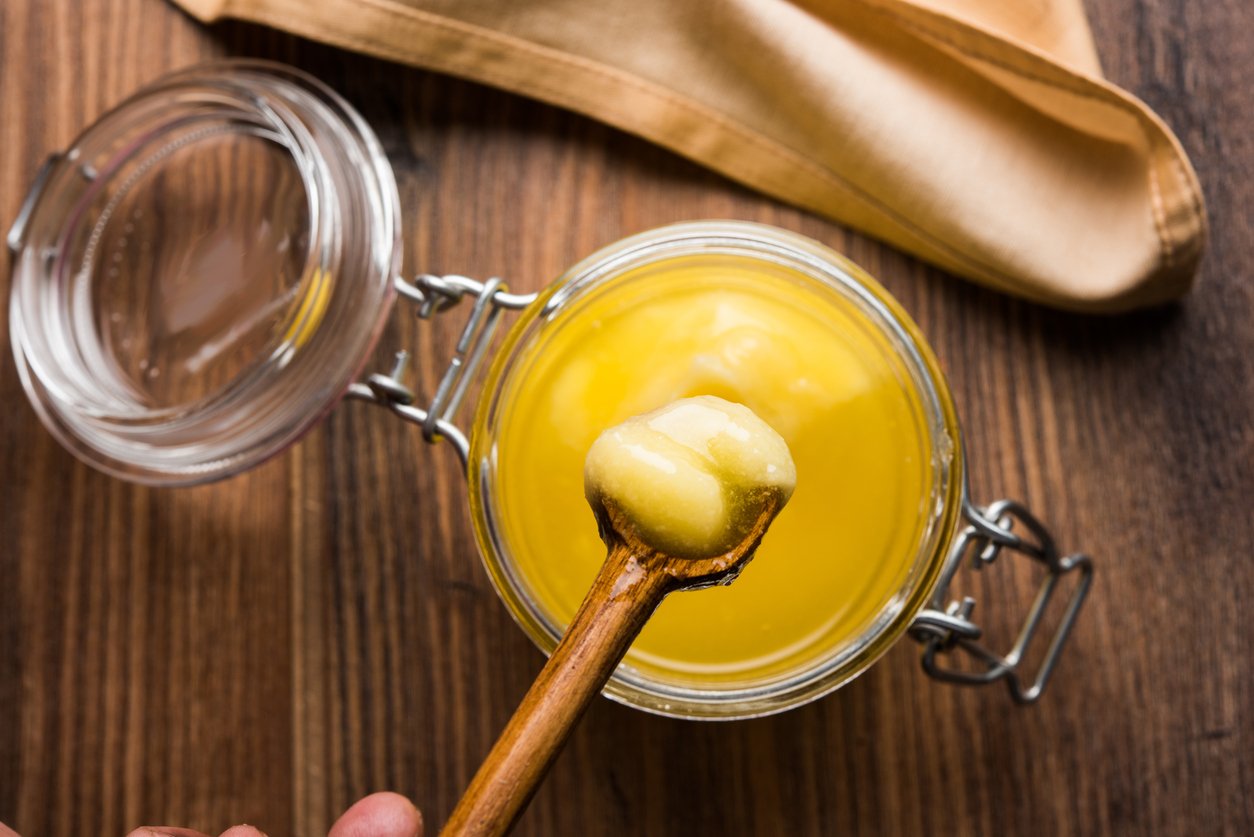How to Choose Healthy Cooking Oils

Let’s face it: Healthy cooking involves a lot of decisions, some easier to make than others. Deciding which oils to cook with, which ones to drizzle over your salad and which ones to stay very, very far away from is trickier – especially when so many labels make confusing health claims.
Fear not – choosing healthy cooking oils doesn’t need to be complicated. Just follow this handy guide to choosing the best oil for each culinary adventure you embark on in your kitchen!
Types of Fats and Cooking Oils
Fats come in chains of varying lengths and are made up of carbon, hydrogen and oxygen atoms. One way fats are distinguished from one another is by their double bonds – whether there are no double bonds, one double bond or many double bonds between the carbon molecules.
The categories of fats include:
Saturated Fats
Bond Type: None
What Are They?
Saturated fats are solid at room temperature and turn to liquid when warmed. They mostly come from animal sources (like butter) and tropical oils like coconut and palm oil. Contrary to popular belief, not all saturated fats are bad. For example, coconut oil is anti-microbial, aids digestion and reduces inflammation, while ghee has a wealth of nutrients that support our health. Yes, saturated fats should be limited, but they aren’t the evil devils that cause multiple ailments, as some would like us to believe.
The man-made hydrogenated saturated fats are the ones to avoid, but the good quality saturated fats are very beneficial.
Get your FREE Step-By-Step Guide to Making Ghee plus 35 more free resource guides!
Fill out the form below for instant access.
Free Resource Library
Enjoy more than 40 downloadable guides, recipes, and resources.
Mono Unsaturated Fats
Bond Type: One Double Bond
What Are They?
Monounsaturated fats are liquid at room temperature, but will harden when put in the refrigerator. These kinds of fats have been made popular by the Mediterranean diet (which are full of them) and are well-known for lowering your risk of heart disease, arthritis and cancer.
Polyunsaturated Fats
Bond Type: Multiple Double Bonds
What Are They?
Polyunsaturated fats are liquid no matter where you store them. They have many double hydrogen bonds in their fat chains, and they are extremely sensitive to heat, light and air. Some of the most well-known polyunsaturated fats are the omega-3 and omega-6 fatty acids, which have gained attention for their ability to reduce inflammation, build cell membranes, improve brain health, reduce heart disease and more.
Omega-3s and omega-6s are essential fats that our bodies can’t make, so we need to gather them from our diet. Both of them are necessary, however we need a very specific ratio of omega-3 to omega-6, and that’s 1:2 to 1:4. Most people have absolutely no problem getting omega-6, as they are typically overflowing in our diets – in fact, in the average North American diet we are getting about 1 omega-3 to 15 omega-6s. Too much omega-6 throws our bodies into a pro-inflammatory state.
Trans Fats
Hydrogenated oils and trans fats are produced by companies that take polyunsaturated oil and transform it into a solid, so it lasts longer on the shelves and is easily spreadable (think margarine). When single and double bonds are hydrogenated, they are more shelf-stable and consistent.
These are made when, under unnaturally high heat, those single and double bonds in the mono and polyunsaturated fats are saturated with hydrogen to make them more predictable at different temperatures. Our bodies can’t actually recognize the chemical structure, and this can lead to things like high cholesterol, heart disease and cancer.
In their natural states, fats are incredible anti-oxidants while in their hydrogenated state they become the opposite, contributing to free radical damage in the body.
decoding label claims on Healthy Cooking Oils
As with many types of foods, cooking oils can have a host of labeling claims. It can be challenging to decode them because different areas of the world have varying standards and labeling laws, plus each oil can have its own optimal method of extraction and processing.
Below are some common explanations for cooking oil labeling claims.
Cold Pressed
Companies make cold pressed oils by grinding nuts or seeds and then pressing them in a heat-controlled environment to extract the oil; the temperature should not go above 120 degrees. This process helps to maintain the oil’s nutrient value and flavour.
Expeller Pressed
An expeller press squeezes the oil using high pressure; no additional heat (or chemicals) is applied; but due to the friction of the press heat is inevitably created.
Refined
Refined oils are ones that are typically filtered, heated, bleached and deodorized after extraction. This makes them more shelf-stable and longer-lasting; but the consequences are a loss of nutrients and the potential damaging effect the chemicals added in the refining process may have.
However, refining can also depend on the type of oil – and some are ‘naturally refined’ without the use of excess heat and chemicals.
Unrefined
Unrefined oils are those that haven’t undergone any processing after extraction; save for some filtering (without chemicals or heat) in some instances. These oils still retain their nutrient properties and flavour.
Virgin and Extra Virgin
You’ll mostly see ‘virgin’ or ‘extra virgin’ applied to olive oil, and it’s the only type of oil that has an international standard for its labeling terms. Extra virgin olive oil comes from the first press; virgin oil the second.
Generally speaking, virgin oils are simply those that are extracted without heat or chemicals. Though you may see ‘extra virgin’ labels on other types of oils, it’s primarily a marketing term and there usually isn’t much difference between virgin and extra virgin.
If you’re looking at a product and wondering if it’s a healthy cooking oil or not, another rule of thumb is to get in touch with the oil producer or company to find out more information about how their products are processed.
How Do You Decide Which oil is The Best to Cook With?
The more double bonds a fat has, the more susceptible it is to heat, light and oxygen. That means delicate fats such as flax oil, chia oil, and walnut oil are going to be easily destroyed by heat, while the stable fats such as ghee, coconut oil, lard and tallow will be more suitable for high-heat cooking.
With this guide in mind, you can ensure you are choosing healthy cooking oils in the proper way to maintain their health benefits!
Healthy Cooking Oils

Ghee
Type of Fat: Saturated
Temperature: High heat cooking
Best Uses: As a replacement for butter in many recipes. Ghee is also a cooking oil you can make at home
How to Store: A cool dark place for 3 months, in the fridge for up to a year
Coconut Oil
Type of Fat: Saturated
Temperature: High heat cooking
Best Uses: Butter replacement, gluten-free baking, elixirs and hot drinks, homemade body care
How to Store: A cool dark place
Avocado Oil
Type of Fat: Monounsaturated
Temperature: High heat cooking
Best Uses: Sautéing, stir-fries, dips, sauces and dressings
How to Store: A cool dark place
Sesame Oil
Type of Fat: Monounsaturated
Temperature: Low to medium heat cooking
Best Uses: Stir-fries, noodle dishes, dressings, Asian-inspired dishes
How to Store: A cool dark place
Olive Oil
Type of Fat: Monounsaturated
Temperature: Low to medium heat cooking
Best Uses: Light sautéing, dips, sauces and dressings
How to Store: A cool dark place
Flax Oil
Type of Fat: Polyunsaturated
Temperature: Do not heat
Best Uses: Drizzle over salads, cooked whole grains and meat/poultry/fish, add to smoothies and dips
How to Store: In the fridge or freezer
Hemp
Type of Fat: Polyunsaturated
Temperature: Do not heat
Best Uses: Drizzle over salads, cooked whole grains and meat/poultry/fish, add to smoothies and dips
How to Store: In the fridge or freezer
Chia Oil
Type of Fat: Polyunsaturated
Temperature: Do not heat
Best Uses: Drizzle over salads, cooked whole grains and meat/poultry/fish, add to smoothies and dips
How to Store: In the fridge or freezer
Walnut Oil
Type of Fat: Polyunsaturated
Temperature: Do not heat
Best Uses: Drizzle over salads, cooked whole grains and meat/poultry/fish, add to smoothies and dips
How to Store: In the fridge or freezer
Best Practices for Healthy Cooking Oils
Keep these tips in mind when choosing healthy cooking oils.
- Buy oils in small bottles to keep them fresh for as long as possible
- Buy oils sold in glass where possible instead of plastic
- Purchase organic oils
- Always store oils in a cool, dark place
- Buy cold-pressed, unrefined oils where possible (we avoid the refined oils)
- Keep all polyunsaturated oils in the fridge
Cooking Oils to Avoid
Though you may find some of the following oils in organic, cold-pressed versions, we recommend avoiding these oils when found in ultra-processed foods and in plastic bottles.
- Soybean oil
- Corn oil
- Cottonseed oil
- Canola oil
- Rapeseed oil
- Sunflower oil
- Grapeseed oil
- Safflower oil
- Rice bran oil
In the infographic below, we break it down visually – you can see which healthy cooking oils are great for high heat, medium-heat, and no-heat cooking.
Free Resource Library
Enjoy more than 40 downloadable guides, recipes, and resources.


























